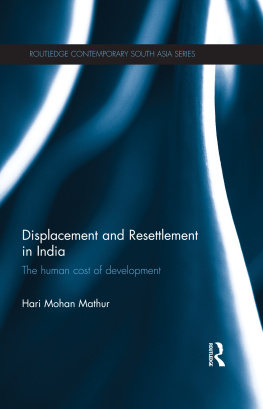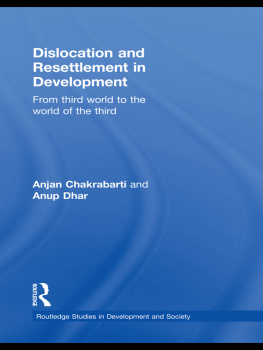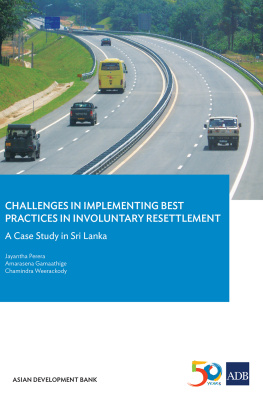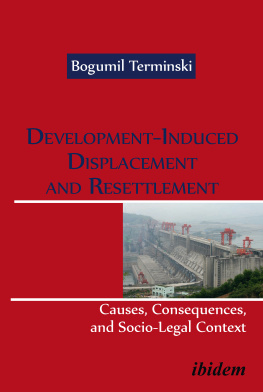
Involuntary Migration and Resettlement
Also of Interest
Vietnamese Americans: Patterns of Resettlement and Socioeconomic Adaptation in the United States, Darrel Montero
Illegal Immigration , Shelby D. Gerking and John H. Mutti
Studies of the Third Wave: Recent Migration of Soviet Jews to the United States , edited by Dan N. Jacobs and Ellen Frankel Paul
Japanese Americans: Changing Patterns of Ethnic Affiliation Over Three Generations , Barrel Montero
Acculturation: Theory, Models, and Some New Findings , edited by Amado M. Padilla
Migration and the Labor Market in Developing Countries , edited by R. H. Sabot
Emigration and Economic Development: The Case of the Yemen Arab Republic , Jon C. Swanson
Jewish Assimilation in Modern Times , edited by Bela Vago
The Chicano Experience , edited by Stanley A. West and June Macklin
Temporary Alien Workers in the United States: Designing Policy from Fact and Opinion , Sidney Weintraub and Stanley Ross
A Westview Special Study
Involuntary Migration and Resettlement: The Problems and Responses of Dislocated People
edited by Art Hansen and Anthony Oliver-Smith
Involuntary migration occurs when there has been, or will be, a catastrophic change in people's environment and they have little or no choice but to relocate. Causes range from natural disasters to sociopolitical upheaval (war, revolution, pogrom) and even to planned changes (dams, atomic experimentation, urban renewal). Although there are excellent studies of specific instances of forced migration, this book is the first to address the broad scope of issues and the wide variety of contexts in which migration and resettlement schemes have occurred. The authors investigate the responses of dislocated people facing dislocation and resettlement and ask specifically: What are the common stresses of dislocation and resettlement? What are the patterns of individual and group reactions and strategies as people respond to the stresses and opportunities of relocation? What significant similarities and differences exist among situations of involuntary migration and how do these pressures relate to those faced by people who move voluntarily?
Dr. Art Hansen is assistant professor of anthropology at the University of Florida, where he is affiliated with the Centers for African Studies, Latin American Studies, and Tropical Agriculture. He has done research on rural development in Bolivia, the Dominican Republic, Zambia, and Malawi and has studied Cuban refugees in Miami. Dr. Anthony Oliver-Smith is associate professor of anthropology at the University of Florida and is affiliated with the Center for Latin American Studies there. His research and writings focus on socio-cultural responses to externally forced change in the Andean area.
Involuntary Migration and Resettlement
The Problems and Responses of Dislocated People
edited by Art Hansen and Anthony Oliver-Smith
First published 1982 by Westview Press, Inc.
Published 2018 by Routledge
52 Vanderbilt Avenue, New York, NY 10017
2 Park Square, Milton Park, Abingdon, Oxon OX14 4RN
Routledge is an imprint of the Taylor & Francis Group, an informa business
Copyright 1982 Taylor & Francis
All rights reserved. No part of this book may be reprinted or reproduced or utilised in any form or by any electronic, mechanical, or other means, now known or hereafter invented, including photocopying and recording, or in any information storage or retrieval system, without permission in writing from the publishers.
Notice:
Product or corporate names may be trademarks or registered trademarks, and are used only for identification and explanation without intent to infringe.
Library of Congress Cataloging in Publication Data
Main entry under title:
Involuntary migration and resettlement.
(A Westview special study)
Bibliography: p.
Includes index.
1. Emigration and immigration. 2. Refugees. 3. Land Settlement.
I. Hansen, Art. II. Oliver-Smith, Anthony.
JV6318.I55 1982 325'.2 81-19687
ISBN 13: 978-0-367-02243-3 (hbk) AACR2
Contents
, Anthony Oliver-Smith and Art Hansen
, Art Hansen
, Anita Spring
, G. S. Morrison and Felix Moos
, James A. Pisarowicz and Vicki Tosher
, Anthony Oliver-Smith
, James L. Merryman
, Joseph 0. Palacio
, Brian M. du Toit
, Sigrid Khera and Patricia S. Mariella
, David Price
, Conrad C. Reining
, Janice E, Perlman
, William L. Partridge, Antoinette B. Brown, and Jeffrey B. Nugent
, Thayer Scudder and Elizabeth Colson
The editors would like to thank the individual authors of the articles for their cooperation in the production of this volume. We would also like to thank the University of California Press for permission to publish by Art Hansen. Thanks are due as well to a number of people at the University of Florida, including H. Russell Bernard and Elizabeth Eddy, for their support during their respective tenures as chair of the Department of Anthropology; Carol Bates and Beth Scott for the production and design of many of the graphics, proofreading, and bibliographical work; and Mary Fearn, Robin Goepfert, and Darla Wilkes for typing the numerous drafts through which this volume passed. To all involved, our thanks.
A. H.
A. O.-S.
1
Introduction Involuntary Migration and Resettlement: Causes and Contexts
Anthony Oliver-Smith Art Hansen
This volume results from our common interest in the problems of dislocated peoples and our commitment to a comparative case study approach. We are social anthropologists who have lived among and observed the resettlement of dislocated peoples. Art Hansen has worked with rural refugees from an African war and spent some months studying Cuban refugees in the U.S.A.; Anthony Oliver-Smith has worked with victims of a disastrous South American earthquake and avalanche that obliterated the town where his informants used to live. Both the refugees and the avalanche victims had experienced uprooting and relocation and were coping with the consequent stresses and the need to adapt to new or radically changed environments. In extended conversations between us, with other faculty members, and with graduate students, all began to appreciate the extent to which the data and conclusions of each person's research complemented and enriched those of the others. Although the places and peoples were geographically and culturally distinct and the sociopolitical environments and causes of dislocation were dissimilar, there emerged a number of common concerns and processes.
In order to explore the emergent similarities in more depth and with broader ethnographic coverage, we organized a symposium on the topic of "Involuntary Migration and Resettlement: The Problems and Responses of Dislocated Peoples" for the 1976 annual meeting of the American Anthropological Association in Washington, D.C. Six case studies about people in East and South Africa, the Andes, and the southwestern U.S.A. examined specific instances of dislocation as the result of sociopolitical upheavals, natural disasters, or planned removals. Four discussants (Elizabeth Colson, Thayer Seudder, David Maybury-Lewis, and Michael Horowitz) analyzed the cases that were presented and compared them with their own research.







